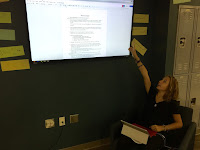
Biology students have been studying ecology, particularly how energy flows through an ecosystem. Students used ecological pyramids to look at the different interactions between organisms.
 The highlight of learning about food webs was the dissection of owl pellets, or as Mrs. Novak likes to say, "barf balls". The students worked hard on separating fur from the bones of small rodents that a barn owl had preyed upon.
The highlight of learning about food webs was the dissection of owl pellets, or as Mrs. Novak likes to say, "barf balls". The students worked hard on separating fur from the bones of small rodents that a barn owl had preyed upon.  |
Here is an example of bones one group found in an owl pellet. Finding skulls was the best!
After collecting the bones in the owl pellet, students could identify the type of rodent the owl most likely ate, use additional background information to produce a model of a food web, and calculate the pyramid of biomass and numbers.




















